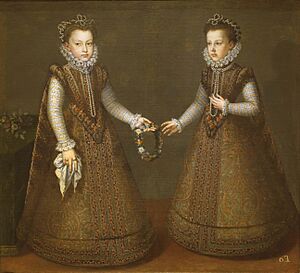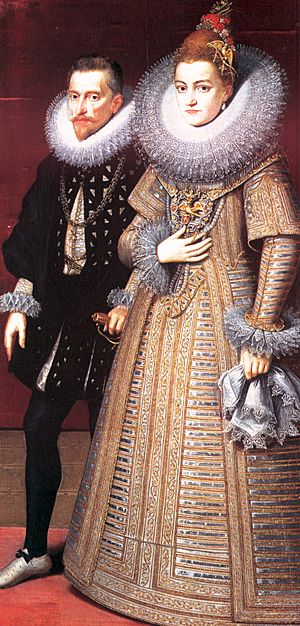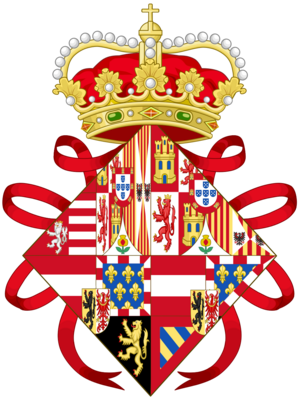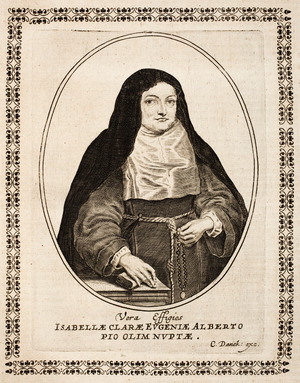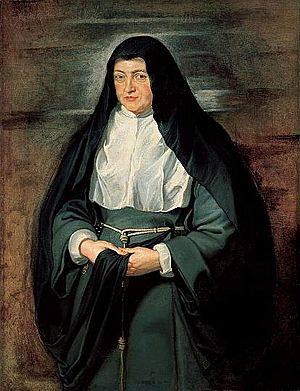Isabella Clara Eugenia facts for kids
Quick facts for kids Isabella Clara Eugenia |
|
|---|---|

Portrait by Frans Pourbus the Younger
|
|
| Sovereign of the Netherlands Duchess of Lothier, Brabant, Limburg, Luxemburg, and Guelders Margravine of Namur Countess Palatine of Burgundy Countess of Flanders, Artois, and Hainaut |
|
| Reign | 6 May 1598 – 13 July 1621 |
| Predecessor | Philip II |
| Successor | Philip IV |
| Co-monarch | Albert |
| Governor of the Habsburg Netherlands | |
| Reign | 13 July 1621 – 1 December 1633 |
| Predecessor | Independent Sovereignty of the Netherlands |
| Successor | Ferdinand of Austria |
| Born | 12 August 1566 Palacio de Valsaín, Segovia, Spain |
| Died | 1 December 1633 (aged 67) Brussels, Brabant |
| Burial | Cathedral of St. Michael and St. Gudula |
| Spouse | |
| House | Habsburg |
| Father | Philip II of Spain |
| Mother | Elisabeth of Valois |
| Religion | Roman Catholicism |
Isabella Clara Eugenia (Spanish: Isabel Clara Eugenia; 12 August 1566 – 1 December 1633) was a very powerful woman in Europe during the 16th and 17th centuries. She ruled the Spanish Netherlands (which is now parts of Belgium, Luxembourg, and northern France) alongside her husband, Albert VII, Archduke of Austria.
Their time as rulers is often called the Golden Age of the Spanish Netherlands. This was a period of peace and growth for the region.
Contents
Isabella Clara Eugenia: A Powerful Ruler
Her Early Life
Growing Up Royal
Isabella Clara Eugenia was born on August 12, 1566, in a palace in Segovia, Spain. Her father was Philip II of Spain, the King of Spain. Her mother was Elisabeth of Valois, Philip's third wife.
Her father was very happy when she was born. He said he was even happier than if he had a son. He already had a son, Carlos, Prince of Asturias, but they didn't get along well.
Isabella was baptized by a special church official who later became Pope Urban VII. Her uncle, John of Austria, was her godfather. She was named after her mother and a saint.
A year later, her younger sister, Catalina, was born. Their parents loved their daughters very much. They bought them toys, dolls, and treats. Sadly, their mother died in 1568.
Isabella and Catherine were raised by their father and their stepmother, Anna of Austria, Queen of Spain. Philip's fourth wife, Anna, was also very loving. The sisters became very close.
A Smart and Educated Princess
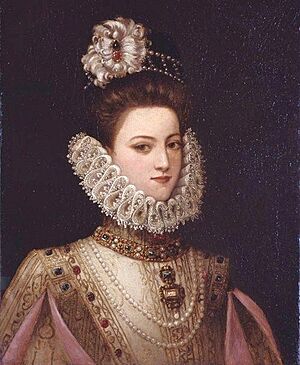
Isabella and Catherine were cared for by their stepmother's lady-in-waiting, Margarita de Cardona. Both sisters were known for being smart. They knew their important place in society.
Isabella received an excellent education. She studied politics, math, and several languages. These included Dutch, French, and Italian, besides her native Spanish. The famous artist Sofonisba Anguissola was a court painter at the time. She helped Isabella with her artistic skills. Isabella was the only person her father allowed to help him with his work. She would sort his papers and translate Italian documents into Spanish for him.
Claim to the French Throne

Isabella's uncle, Henry III of France, was killed in 1589. After his death, her father, King Philip II, claimed the French throne for Isabella. However, France had a law called Salic law. This law meant that women could not inherit the throne.
Also, Isabella's mother had given up her claim to the French throne when she married the Spanish King. Even so, a powerful group in Paris declared Isabella the "legitimate sovereign" of France. But the true heir, Henry IV of France, became Catholic and was crowned King in 1594.
Her Marriage and Rule
Waiting for a Husband

As a Spanish and Portuguese princess, Isabella was a good match for political marriages. However, she married later in life than most women of her time.
When she was two years old, Isabella was promised to her cousin, Rudolf II, Holy Roman Emperor. But Rudolf was a bit unusual. He waited more than 20 years before saying he didn't want to marry anyone. During this time, Isabella took care of her father. He was very ill with gout in the last three years of his life.
Becoming a Co-Ruler
King Philip II decided to give the Spanish Netherlands to Isabella. But there was a condition: she had to marry her cousin, Albert VII, Archduke of Austria. Albert was Rudolf's younger brother and a former leader in the Netherlands.
They would rule the Netherlands together. If they had children, their children would inherit the land. If a daughter inherited, she would have to marry the King of Spain or someone chosen by him. If they had no children, the Netherlands would return to the King of Spain after their deaths.
Albert was an archbishop, a high-ranking church official. He needed special permission from Pope Clement VIII to leave his religious duties and marry. King Philip II died on September 13, 1598. Just before he died, he gave the Netherlands thrones to Isabella and Albert.
The Pope approved their marriage on November 15. Isabella, who was 33, married Albert in Valencia on April 18, 1599. They had three children, but sadly, all of them died very young.
Ruling the Habsburg Netherlands
From 1601, Archduke Albert and Archduchess Isabella ruled the Habsburg Netherlands together. Their rule was a very important time for the region. After Albert died, Isabella became the Governor of the Netherlands. She ruled on behalf of the King of Spain.
Her half-brother's son, Cardinal-Infante Ferdinand of Austria, took over as Governor in 1633.
Foreign Relations
The first part of Albert and Isabella's rule was filled with war. They tried to make peace with the United Provinces and Queen Elizabeth I of England, but it didn't work. So, they focused on winning battles to make their enemies negotiate.
To achieve their goals, Albert and Isabella used many ways to share their message. They used art, especially the baroque style, which was popular after the Counter-Reformation. Their court in Brussels became a major center for politics and art in Europe. It was a place where many different people gathered. These included artists, diplomats, spies, and officials from various countries. Brussels became a key link for the Habsburg family's plans across Europe.
A peace treaty was signed with England on July 24, 1604, called the Treaty of London. This happened after James VI of Scotland became King James I of England. There were still some tensions, especially over religion, but relations were generally friendly.
In 1609, the Dutch Republic agreed to a ceasefire. This led to the Twelve Years' Truce signed in Antwerp. This truce meant the United Provinces were seen as an independent power. After 40 years of war, this treaty brought much-needed peace to the Southern Netherlands.
Economic Growth
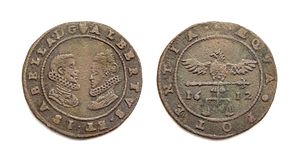
The period of the Truce brought peace and helped the economy. Farmers could safely work their fields again. The rulers encouraged people to reclaim land that had been flooded during the wars. They also supported turning marshy areas into useful land.
More farming led to a small increase in the population. This meant more workers. Industries, especially luxury goods, also recovered. This brought good economic stability and wealth to the Southern Netherlands.
However, international trade was difficult because the river Scheldt was closed. The rulers planned to build canals to get around this problem. These canals would connect cities like Ostend, Bruges, Ghent, and link the Meuse and Rhine rivers. To help with urban poverty, the government also created a system of public pawnshops, called Monti di Pietà.
Religious Changes
Albert and Isabella's rule helped the Catholic Reformation succeed in the Habsburg Netherlands. Most Protestants had already left the region. After 1597, those who stayed were not actively hunted down.
A law passed in 1609 allowed Protestants to live there. However, they could not worship in public or do other religious activities openly. The rulers also supported new and reformed religious groups. The Jesuits received the most money. This helped them build impressive churches in Brussels and Antwerp. The Capuchins also received a lot of support.
Strengthening Royal Power
Albert and Isabella Clara Eugenia made the ruler's power stronger in the Habsburg Netherlands. The main assembly of the provinces, the States General, was only called once in 1600. After that, the government preferred to work directly with each province.
The years of peace allowed the rulers to create many new laws. For example, the Eternal Edict of 1611 changed the justice system. It helped move from old customs to written laws. Other laws dealt with money, the nobility, and even duels.
Relationship with Spain
The actions of Albert and Isabella helped create a unique identity for the Southern Netherlands. However, since their children died young, it became clear they would not have heirs. This meant the Netherlands would not become fully independent.
So, Albert and Isabella then focused on bringing the Southern Provinces back into the Spanish monarchy. They made the House of Habsburg's power strong in the region. They also helped calm down feelings against Spain. Because of this, the provinces agreed to accept the King of Spain as their heir. This happened in ceremonies between 1616 and 1617.
After Albert died in 1621, Isabella became the King of Spain's Governor. She had some successes, like the capture of Breda in 1625. But there were also setbacks, like losing 's-Hertogenbosch in 1625 and Maastricht in 1632.
Patronage of Arts
The Brussels Court

Isabella and Albert strongly supported the arts. This led to the creation of the Flemish Baroque painting style. They supported famous artists and architects. These included Peter Paul Rubens (their court painter), Wenceslas Cobergher, and Jacob Franquart. Their support made the Brussels Court one of Europe's most important art centers.
Sadly, almost nothing remains of their palace in Brussels or their country homes. Their amazing art collections were scattered after 1633, and much of it is lost. Still, the Archdukes are remembered as great supporters of the arts. The best-preserved art from their time is at Scherpenheuvel. Here, Albert and Isabella guided artists to create a beautiful pilgrimage church.
Descalzas Reales Convent
Isabella joined a religious group called the Secular Franciscan Order and became a nun. She was very important to the Convent of Las Descalzas Reales in Spain. She lived there with her mother-in-law, Maria. Isabella gave many important artworks to the convent. This included a famous series of tapestries from Brussels. These tapestries were designed by Peter Paul Rubens. They show Isabella as the patron saint Clare of Assisi.
Images for kids
See also
 In Spanish: Isabel Clara Eugenia de Austria para niños
In Spanish: Isabel Clara Eugenia de Austria para niños


